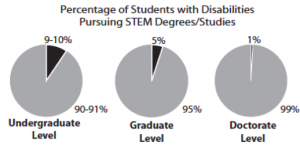Accessibility in Labs and Practicals
Providing support and addressing challenges as a TA
In Canada, 2% of students at post-secondary institutions are registered to receive disability related services from their institutions (Fitchen et al. 2003). More recent data from Ontario universities, indicates that 6.6% of graduating students at Ontario universities report having a disability (McCloy & Declou, 2013, p. 17). At the University of Toronto, 4216 students are registered with Accessibility Services (AS) at the St. George Campus in 2017-2018. While these numbers are reported directly by AS, it is important to keep in mind that these statistics do not represent students not registered and, thus, provide only partial information about the number of students who may need these services. Many of students with disabilities regularly face barriers which inhibit them to fully participate and engage in the classroom.
STUDENTS WITH DISABILITIES IN STEM FIELDS
However, students who identify as having a disability are vastly under-represented in STEM fields: according to the Individuals with Disabilities Education Act (IDEA), only 9-10% of all students in the US that identified themselves as someone with a disability were enrolled in STEM majors (Moon et al., 2012), and these percentages drop substantially at higher levels of education.
(From Moon et al., 2012)
There are many reasons why students with disabilities might be so under-represented in STEM fields. For one, laboratory environments are typically physically inaccessible to students with physical disabilities, and the barriers to access—even at the very junior levels of study—can seem to be very high to students: as Sukhai et al. (2014) note, “At best, the physical structure of most laboratories is unwelcoming to personal with physical disabilities; at worst, it is inaccessible” (p. 6).
ACCESSIBILITY SERVICES AND ACCOMMODATIONS
While some of these things may be true, especially regarding the physical design of laboratories, there are a lot of ways that laboratory environments can be made accessible and safe for students with many types of physical and intellectual needs. There is a responsibility at all levels of the university to create laboratory environments that are accessible to and that meet the needs of any student that wishes to access them. The University of Toronto has a stated commitment to “fostering academic community in which the learning and scholarship of every member may flourish, with vigilant protection for individual human rights, and a resolute commitment to the principles of equal opportunity, equity and justice” (University of Toronto, 1992). Students with disabilities can work with accessibility services (AS) at each of the campuses to determine necessary accommodations, which are communicated to the faculty, the department, and individual instructors (professor or course instructor) so that any structural issues that could present barriers to that student’s ability to fully participate in the laboratory environment.
Teaching Assistants’ Role in Accommodations
Universal Design
References and Resources
Created by Sanaz Ghasemi and Kris Kim, TATP Science Trainers © 2018
Updated by Nicole Birch-Bayley, Faculty Liaison Coordinator, TATP/CTSI © 2022
